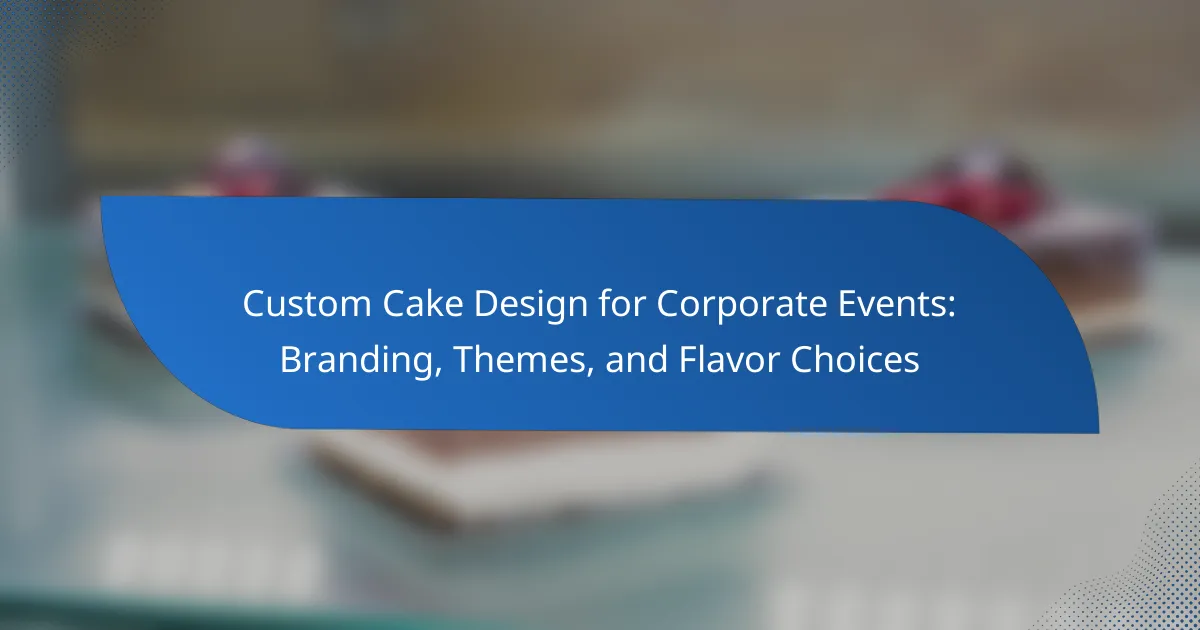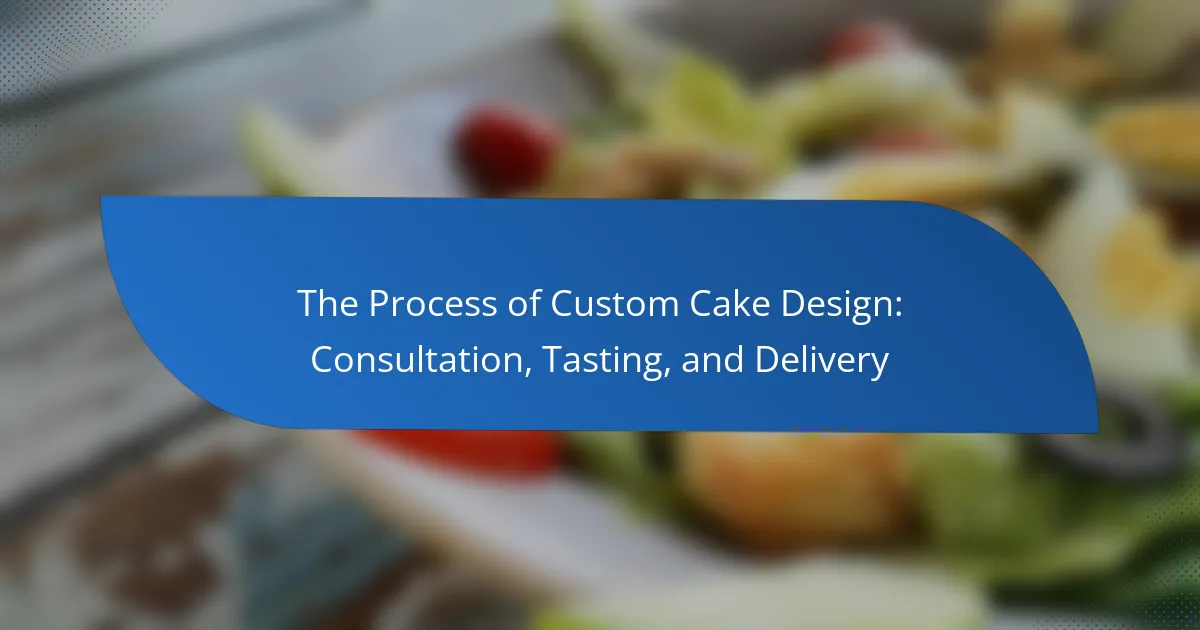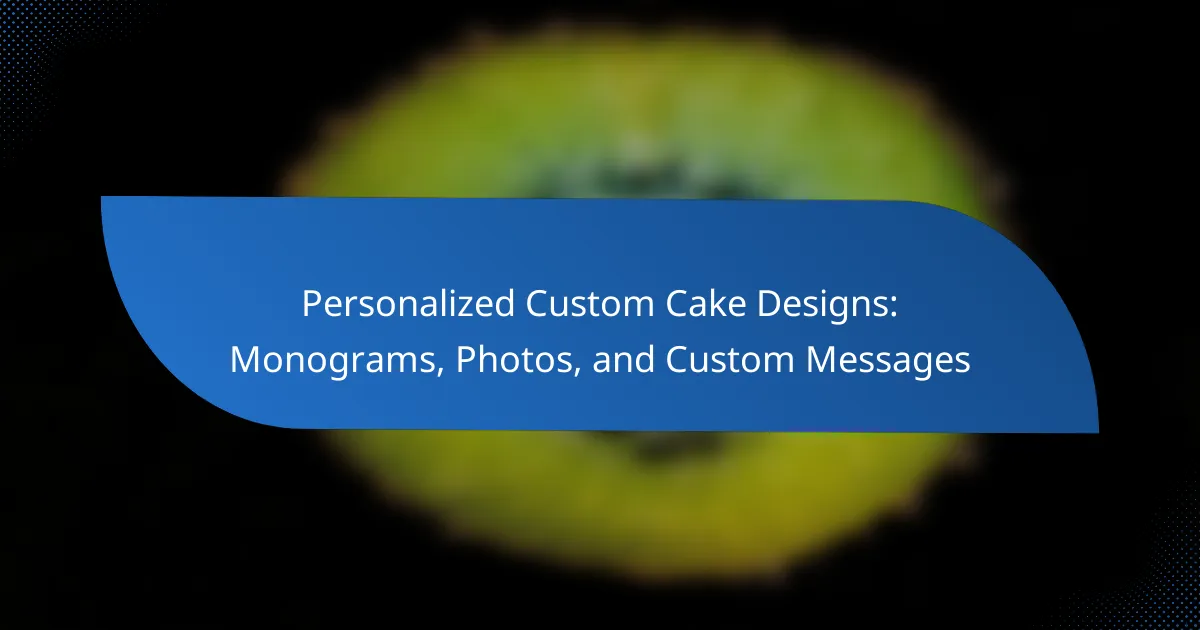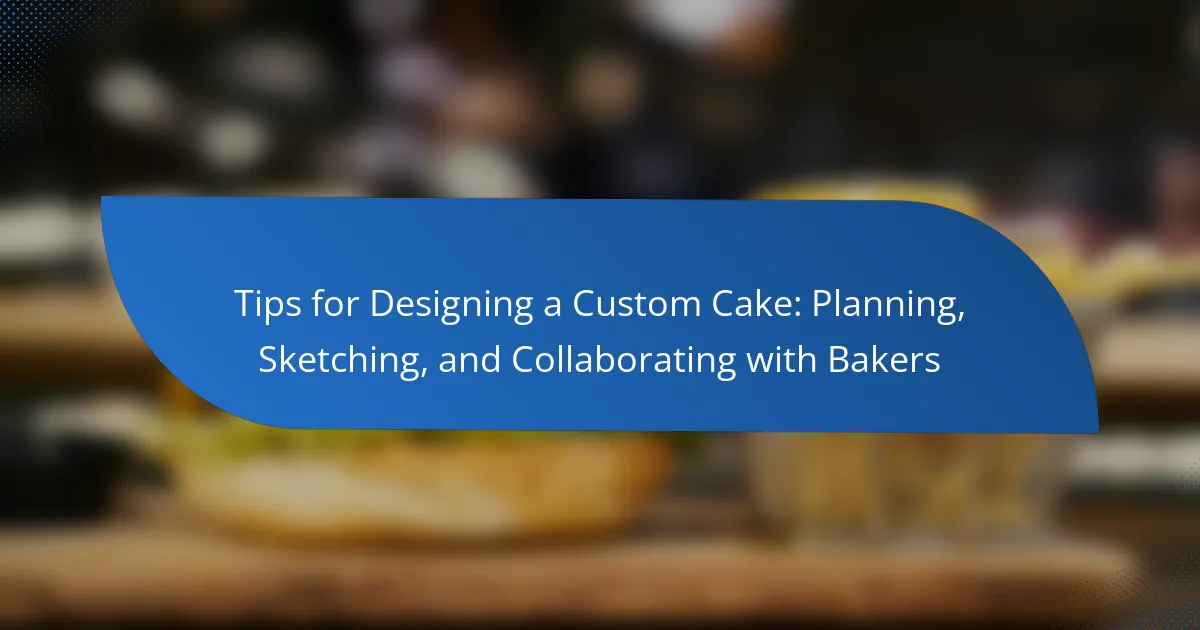Custom cake design for special diets involves creating cakes that cater to specific dietary restrictions such as gluten-free, vegan, and sugar-free. Gluten-free cakes utilize alternative flours like almond or coconut flour, while vegan cakes replace animal products with plant-based substitutes such as applesauce or flaxseed. Sugar-free cakes are made with natural sweeteners like stevia or erythritol, ensuring that individuals with dietary limitations can enjoy celebratory desserts. This article outlines the types of special diet cakes, the ingredients needed for each, and guidelines for creating custom cakes that meet these dietary needs effectively.
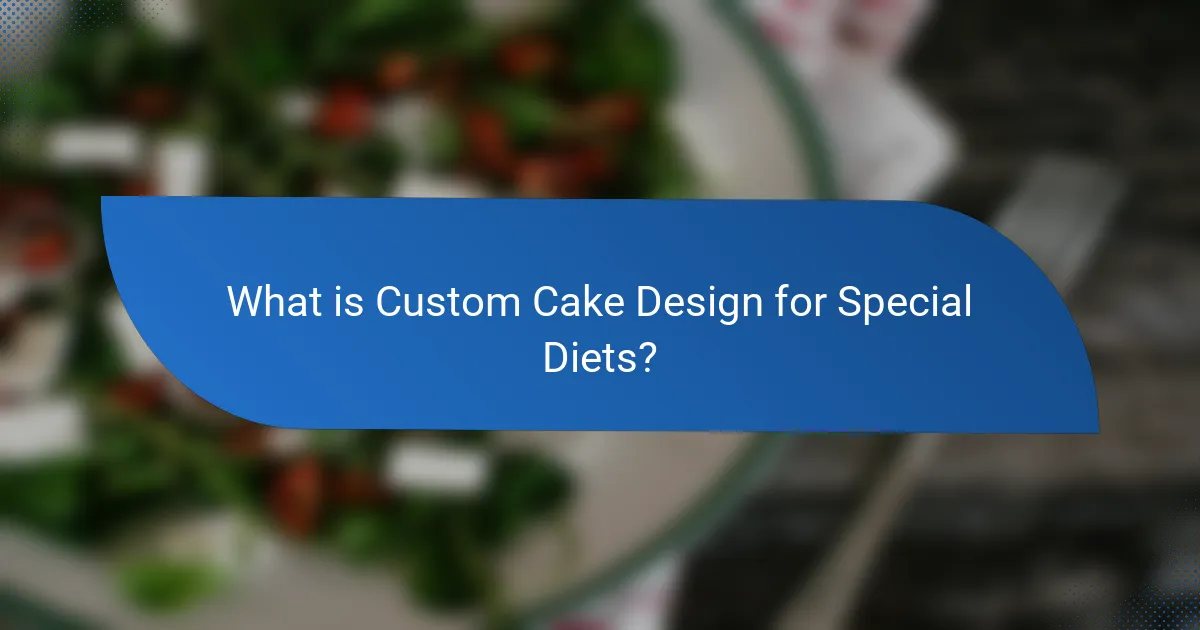
What is Custom Cake Design for Special Diets?
Custom cake design for special diets refers to the creation of cakes tailored to meet specific dietary restrictions. This includes options such as gluten-free, vegan, and sugar-free cakes. These custom cakes are made using alternative ingredients that align with the dietary needs of individuals. For example, gluten-free cakes utilize gluten-free flours like almond or coconut flour. Vegan cakes replace eggs and dairy with plant-based alternatives. Sugar-free cakes use sweeteners like stevia or erythritol instead of traditional sugar. Custom cake design ensures that everyone can enjoy celebratory cakes without compromising their health requirements.
How do special diets influence cake design?
Special diets significantly influence cake design by dictating ingredient choices and preparation methods. Gluten-free cakes require alternative flours, such as almond or coconut flour, to replace traditional wheat. Vegan cakes eliminate animal products, often using plant-based substitutes like flaxseed or applesauce for binding. Sugar-free cakes rely on natural sweeteners like stevia or erythritol to achieve desired sweetness without sugar. Each dietary requirement necessitates unique flavor profiles and textures, impacting overall design aesthetics. For instance, gluten-free cakes may need additional moisture to counteract dryness. Vegan cakes often incorporate rich flavors to compensate for the absence of eggs and dairy. These adaptations lead to innovative designs that cater to specific dietary needs while maintaining visual appeal and taste.
What are the key attributes of gluten-free cake design?
The key attributes of gluten-free cake design include the use of alternative flours, moisture retention, and flavor enhancement. Alternative flours such as almond, coconut, or rice flour are essential. These flours provide structure without gluten. Moisture retention is crucial to prevent dryness. Ingredients like applesauce or yogurt can help achieve this. Flavor enhancement is important to compensate for the lack of gluten. Adding spices, vanilla, or citrus can improve taste. Additionally, gluten-free cakes often require specific binding agents like xanthan gum or flaxseed. These agents help mimic the texture of traditional cakes. Lastly, presentation and decoration should align with gluten-free principles. This ensures the cake is visually appealing and safe for consumption.
How does veganism affect cake ingredient choices?
Veganism significantly affects cake ingredient choices by eliminating all animal-derived products. This means traditional ingredients like eggs, milk, and butter are replaced. Common substitutes include applesauce, mashed bananas, and plant-based milks. These alternatives provide moisture and binding properties essential for cake structure. Additionally, vegan cakes often use oils or vegan butters instead of dairy butter. Ingredients like aquafaba, the liquid from canned chickpeas, can replace egg whites for leavening. The use of non-dairy yogurt can also enhance texture and flavor. This shift in ingredients requires careful consideration of flavor profiles and texture to maintain cake quality. Vegan recipes often adapt to ensure that cakes remain delicious and appealing.
What makes sugar-free cakes unique in design?
Sugar-free cakes are unique in design due to their use of alternative sweeteners. These sweeteners, such as stevia or erythritol, influence the cake’s texture and flavor profile. The absence of sugar often requires adjustments in ingredient ratios. This can lead to denser or moister cakes compared to traditional recipes. Additionally, sugar-free cakes often incorporate more natural flavors, such as fruits or spices, to enhance taste. The design may also include creative decorations that appeal visually without relying on traditional sugary elements. Overall, the focus on health and dietary needs shapes the aesthetic and functional aspects of sugar-free cakes.
Why is custom cake design important for special diets?
Custom cake design is important for special diets because it ensures that individuals with dietary restrictions can enjoy desserts safely. Many people have allergies or intolerances to common ingredients like gluten, dairy, or sugar. Custom cakes can be tailored to exclude these ingredients while still providing flavor and texture. For example, gluten-free cakes use alternative flours like almond or coconut flour. Vegan cakes replace eggs and dairy with plant-based options, such as applesauce or almond milk. Sugar-free cakes utilize natural sweeteners like stevia or erythritol. This customization allows everyone to partake in celebrations without health risks. Thus, custom cake design is essential for inclusivity and safety in dietary practices.
How does custom design cater to dietary restrictions?
Custom design caters to dietary restrictions by allowing personalized ingredient selection. This ensures that cakes meet specific dietary needs, such as gluten-free, vegan, or sugar-free. For instance, gluten-free cakes use alternative flours like almond or coconut flour. Vegan cakes replace eggs and dairy with plant-based substitutes. Sugar-free options utilize sweeteners like stevia or erythritol. Custom design also accommodates allergies, ensuring safe consumption. This approach enhances satisfaction and inclusivity for diverse dietary preferences.
What role does personalization play in special diet cakes?
Personalization plays a crucial role in special diet cakes by catering to individual dietary needs and preferences. It allows for the customization of ingredients to meet specific health requirements. For example, gluten-free cakes use alternative flours to accommodate gluten intolerance. Vegan cakes replace eggs and dairy with plant-based options for those avoiding animal products. Sugar-free cakes utilize sweeteners suitable for diabetics or those reducing sugar intake. Personalization enhances the enjoyment of desserts without compromising health. This tailored approach also increases customer satisfaction and loyalty.
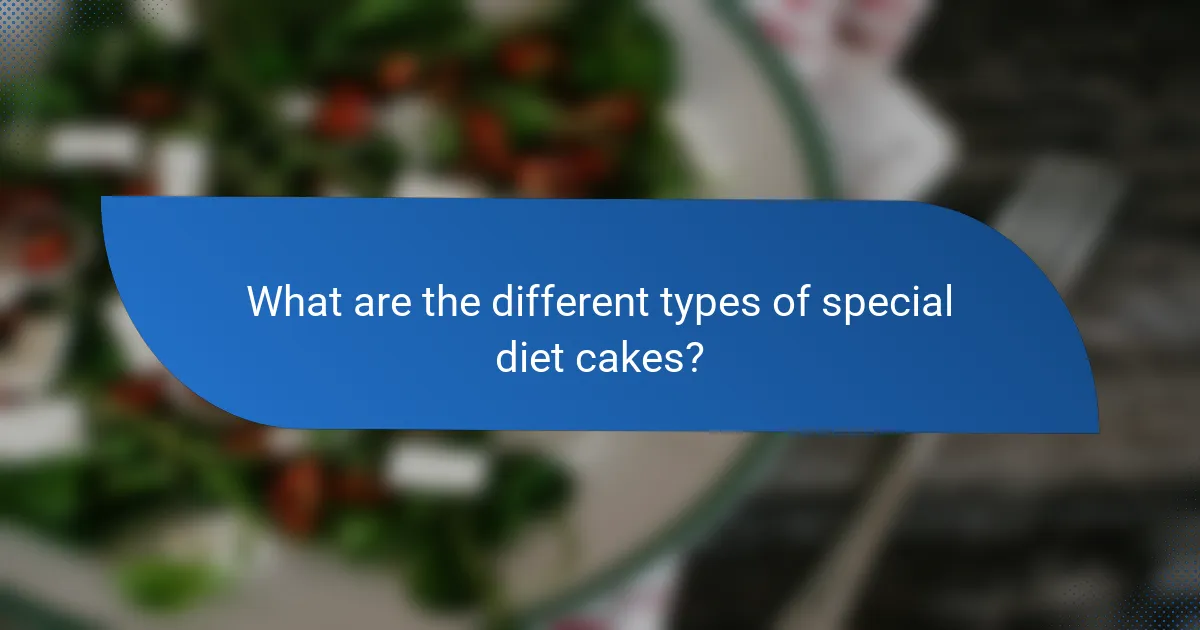
What are the different types of special diet cakes?
The different types of special diet cakes include gluten-free cakes, vegan cakes, and sugar-free cakes. Gluten-free cakes are made without wheat or gluten-containing ingredients. They often use alternative flours such as almond or coconut flour. Vegan cakes exclude all animal products, including eggs and dairy. These cakes utilize substitutes like applesauce or flaxseed for moisture and binding. Sugar-free cakes are designed for those avoiding sugar, often using natural sweeteners like stevia or erythritol. Each type caters to specific dietary needs and preferences, ensuring inclusivity in dessert options.
What options are available for gluten-free cakes?
Gluten-free cakes can be made using various alternative flours. Common options include almond flour, coconut flour, and rice flour. These flours provide different textures and flavors. Almond flour creates a moist cake, while coconut flour is denser. Rice flour is often used for a light and fluffy texture.
Additionally, gluten-free cake mixes are widely available. Many brands offer pre-packaged mixes that simplify the baking process. These mixes often combine multiple gluten-free flours for balanced results.
Fruits and vegetables can also be used in gluten-free cakes. Ingredients like bananas and zucchini add moisture and natural sweetness.
Eggs or egg substitutes are essential for binding in gluten-free recipes. They help achieve the desired structure in the cake.
In summary, gluten-free cakes can be made with various flours, mixes, fruits, vegetables, and binding agents.
How can gluten-free cakes maintain flavor and texture?
Gluten-free cakes can maintain flavor and texture by using alternative flours and binding agents. Common substitutes include almond flour, coconut flour, and rice flour. These flours contribute unique flavors and moisture to the cake. Additionally, incorporating ingredients like applesauce or yogurt can enhance moisture and texture. Using xanthan gum or guar gum helps mimic the elasticity of gluten. This combination of ingredients can create a balanced structure and taste. Research shows that cakes made with these substitutes can achieve comparable sensory qualities to traditional cakes.
What are common gluten-free ingredients used in cake making?
Common gluten-free ingredients used in cake making include almond flour, coconut flour, and rice flour. Almond flour is made from ground almonds and adds moisture and flavor. Coconut flour is derived from dried coconut meat and absorbs a lot of liquid. Rice flour is a staple in gluten-free baking and provides a light texture. Other ingredients include tapioca starch, which helps improve texture, and potato starch, which adds moisture and density. These ingredients are often combined to create a balanced gluten-free cake. They are widely used in recipes and are recognized for their ability to mimic the properties of traditional wheat flour.
What are the best practices for vegan cake design?
The best practices for vegan cake design include using plant-based ingredients and ensuring flavor balance. Incorporate natural sweeteners like maple syrup or agave nectar. Utilize alternatives for eggs, such as flaxseed meal or applesauce, to maintain moisture. Choose dairy-free options like almond or coconut milk for creaminess. Implement creative decorations using fruits, nuts, or edible flowers for visual appeal. Ensure proper structure by using vegan-friendly leavening agents like baking soda and vinegar. Maintain a balance of flavors by combining different extracts, such as vanilla and almond. Finally, consider the cake’s theme and color palette to enhance overall presentation.
How do egg substitutes impact vegan cake recipes?
Egg substitutes significantly impact vegan cake recipes by providing binding and leavening properties. Without eggs, cakes may lack structure and moisture. Common substitutes include applesauce, flaxseed meal, and aquafaba. Each of these alternatives adds moisture and helps the cake rise. For example, flaxseed meal mixed with water can mimic egg binding. Applesauce contributes sweetness and moisture, enhancing texture. Aquafaba, the liquid from chickpeas, can create a light and airy cake. Research shows that using appropriate substitutes can yield cakes with similar taste and texture to those made with eggs. Thus, egg substitutes are essential for successful vegan cake recipes.
What are popular vegan frosting alternatives?
Popular vegan frosting alternatives include coconut cream, avocado, and cashew cream. Coconut cream is rich and provides a creamy texture. It is often whipped to create a light frosting. Avocado offers a unique flavor and is nutrient-dense. It can be blended with cocoa or sweeteners for a chocolate frosting. Cashew cream is made from soaked cashews and can be flavored with vanilla or cocoa. These alternatives are dairy-free and suitable for vegan diets. They maintain a similar texture to traditional frostings while being plant-based.
What considerations are there for sugar-free cake options?
Sugar-free cake options require careful selection of sweeteners and ingredients. Common alternatives include stevia, erythritol, and monk fruit. These substitutes have varying sweetness levels and may affect texture and flavor.
Baking soda or baking powder may need adjustment due to the absence of sugar. Sugar also contributes to moisture retention, so additional liquids might be necessary.
Some sugar-free cakes may rely on natural sweetness from fruits or unsweetened applesauce. It’s important to balance flavors to avoid a bland taste.
Nutritional content should be considered, as some sugar substitutes can have different calorie counts. Testing recipes is crucial to achieve the desired outcome in taste and texture.
How do sugar substitutes affect the taste of cakes?
Sugar substitutes can significantly alter the taste of cakes. They often provide sweetness without the calories of sugar. However, their flavors can vary widely. Some sugar substitutes, like stevia, may impart a slight aftertaste. Others, such as erythritol, can create a cooling sensation in the mouth. The texture of cakes can also be affected. Sugar contributes to moisture and structure; substitutes may not replicate these properties. Research indicates that cakes made with sugar substitutes can differ in flavor and mouthfeel compared to traditional cakes. This variation can influence overall consumer satisfaction.
What are the challenges in creating sugar-free cakes?
Creating sugar-free cakes presents several challenges. One major challenge is achieving the desired sweetness without using sugar. Many sugar substitutes have different sweetness levels and flavors. This can affect the overall taste and texture of the cake. Another challenge is moisture retention. Sugar contributes to moisture in baked goods, so alternatives must be carefully chosen. Additionally, sugar-free cakes can have altered textures. Ingredients like almond flour or coconut flour behave differently than traditional flour. This can result in denser or crumblier cakes. Balancing flavors also becomes more complex. Some sugar substitutes can impart an aftertaste that needs to be masked. Finally, adjusting baking times and temperatures may be necessary. Sugar-free cakes often require different handling than their sugary counterparts. These factors collectively complicate the process of creating appealing sugar-free cakes.
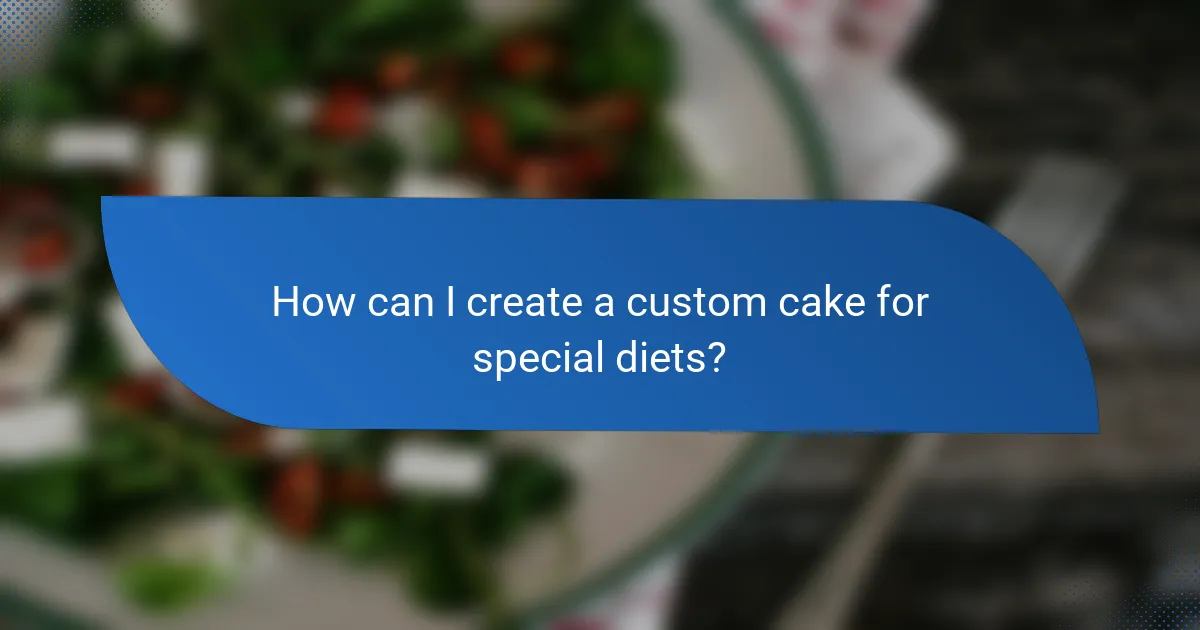
How can I create a custom cake for special diets?
To create a custom cake for special diets, start by identifying the specific dietary restrictions. Common diets include gluten-free, vegan, and sugar-free. For gluten-free cakes, use alternative flours like almond or coconut flour. For vegan cakes, replace eggs with applesauce or flaxseed meal. For sugar-free options, consider using natural sweeteners like stevia or erythritol. Ensure all ingredients are certified for the respective diet to avoid cross-contamination. Follow recipes tailored to these dietary needs for best results. Adjust baking times and temperatures as necessary, since alternative ingredients may behave differently.
What steps should I follow for designing a custom cake?
Define the main entity of the question: Designing a custom cake involves several key steps. Start by determining the cake’s purpose and theme. Gather inspiration from various sources, including online platforms and magazines. Next, select the flavor and dietary requirements, such as gluten-free, vegan, or sugar-free options. Choose the cake size based on the number of servings needed. Create a sketch or layout of the design, considering colors and decorations. Finally, compile a list of ingredients and tools required for the baking process. Following these steps ensures a structured approach to custom cake design.
How do I select the right ingredients for a special diet cake?
To select the right ingredients for a special diet cake, identify the specific dietary requirements first. Gluten-free cakes require alternative flours like almond or coconut flour. Vegan cakes need plant-based substitutes for eggs and dairy, such as flaxseed meal or almond milk. Sugar-free cakes often use natural sweeteners like stevia or erythritol. Each ingredient should align with the dietary restrictions of the intended audience. For example, ensure that all ingredients are certified gluten-free if the cake is for someone with celiac disease. Research shows that using appropriate substitutes can yield successful results in special diet baking.
What design elements should I consider for visual appeal?
Consider color, texture, shape, and presentation for visual appeal in cake design. Color influences mood and attraction. Using contrasting colors can enhance visual interest. Texture adds depth and can be created through icing, fondant, or decorative elements. Shape plays a critical role; unique shapes can captivate attention. Presentation matters significantly; a well-arranged cake on an appealing stand enhances its visual appeal. Each of these elements contributes to the overall aesthetic, making the cake more enticing.
What tips can help ensure success in custom cake design?
To ensure success in custom cake design, focus on understanding client preferences. Communicate clearly to gather details about flavors, themes, and dietary restrictions. Use high-quality ingredients to enhance taste and texture. Experiment with different techniques for decoration and structure. Pay attention to food safety and proper handling practices. Plan the design layout before starting to avoid last-minute issues. Stay updated on trends in cake design to inspire creativity. Lastly, practice regularly to improve skills and build confidence.
How can I troubleshoot common issues in special diet cakes?
To troubleshoot common issues in special diet cakes, identify the specific problem first. For dense or gummy cakes, ensure you are using the correct flour alternatives. Gluten-free flours require different liquid ratios. If cakes are too dry, consider adding moisture through applesauce or yogurt. For cakes that don’t rise, check the freshness of your baking powder or soda. If flavors are lacking, enhance with vanilla or spices suitable for the diet. For uneven baking, rotate the cake during baking for even heat distribution. Lastly, ensure all ingredients are at room temperature unless specified otherwise.
What resources are available for learning more about custom cake design?
Online courses provide structured learning for custom cake design. Websites like Skillshare and Udemy offer classes on cake decorating techniques. YouTube hosts numerous tutorials from professional bakers. Books such as “The Cake Bible” by Rose Levy Beranbaum offer in-depth knowledge. Local baking schools often conduct workshops on custom cake design. Social media platforms feature groups and pages dedicated to cake decorating. Industry blogs provide tips, trends, and inspiration for custom designs. Online forums can connect aspiring bakers with experienced decorators for advice.
Custom cake design for special diets encompasses the creation of cakes tailored to meet dietary restrictions, including gluten-free, vegan, and sugar-free options. Key attributes for gluten-free cakes involve alternative flours and moisture retention, while vegan cakes replace animal products with plant-based substitutes. Sugar-free cakes utilize natural sweeteners, impacting texture and flavor. The article covers the influence of special diets on cake design, best practices for ingredient selection, and troubleshooting common issues, ensuring inclusivity and safety for those with dietary needs.
